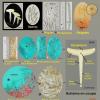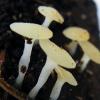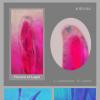
24-12-2025 17:08
Hulda Caroline HolteHello, I have found this propoloid ascomycete on

21-12-2025 09:32
Hello.A tiny ascomycete found embedded in wood in

21-12-2025 21:32
Pol DebaenstHello, Garden, Burgweg 19, Veurne, BelgiumOn 10/1

22-12-2025 23:38
Patrice TANCHAUDBonsoir, récolte sur un mur en pierre, apothéci

22-12-2025 00:47
Patrice TANCHAUDBonsoir, récolte à proximité du milieu dunaire
50144 - Disco inconnu
Roland Labbé,
17-03-2010 03:06
Voici un autre disco inconnu.
Peut être un Hymenoscyphus !
Merci, amitiés ! Roland
Détails :
Date de récolte : 19 / 05 / 2009
Habitat : tas de petites branches
Hôte : bois mort de lilas
Spores longuement ellipsoïdes, rarement légèrement arquées, lisses, à paroi modérément épaissie, rarement à 1 septum, biguttulées, hyalines verdâtres en NaCl iso., 7-14 x 2,5-3,5 µm, 9,6 x 2,9 µm en moyenne (23 spores), Q = 3,31
Asques à 8 spores uni ou bisériées, avec appareil apical amyloïde, 50-84 x 4-8 µm (10 asques)
Paraphyses rares, cylindriques, graduellement légèrement élargies vers l’apex obtus, à contenu finement granuleux ou réfringent, 78-85 x 1,5-2 µm (4 paraphyses)
Excipulum ectal formé de cellules largement cylindriques, parfois renflées, à paroi mince, 27-55 x 20-30 µm (5 cellules)
Cellules subglobuleuses en chaîne aussi présentes au niveau de la paroi externe de l'excipulum
Le schéma dans la planche explique un peu où les coupes ont été faites.
Hans-Otto Baral,
17-03-2010 08:08

Re:50144 - Disco inconnu
Hi Roland
I thought it is Hymenosc. repandus, but the apical ring I do not like. Do you have more photos of the blue ring? The ring looks more like a Cyathicula, but the excipulum does not.
Important would be to photograph living elements. Only the spores are alive on your pics. Not necessary to use Iso-solutions, but live elements! You say the paraphyses contain granular contents, but maybe you stated that from dead paraphyses. The living should have contained abundant VBs, very different from your photo.
The ascus widt of 4-8 µm is a very broad range. Either you included very immature asci, or you mixed living and dead asci.
Subhymenium is a layer just beneath the hymenium. What you indicate is the medullary excipulum.
Zotto
I thought it is Hymenosc. repandus, but the apical ring I do not like. Do you have more photos of the blue ring? The ring looks more like a Cyathicula, but the excipulum does not.
Important would be to photograph living elements. Only the spores are alive on your pics. Not necessary to use Iso-solutions, but live elements! You say the paraphyses contain granular contents, but maybe you stated that from dead paraphyses. The living should have contained abundant VBs, very different from your photo.
The ascus widt of 4-8 µm is a very broad range. Either you included very immature asci, or you mixed living and dead asci.
Subhymenium is a layer just beneath the hymenium. What you indicate is the medullary excipulum.
Zotto
Roland Labbé,
17-03-2010 20:36
Re:50144 - Disco inconnu
Hi Zotto !
Tel que demandé, l'appareil apical des asques a été revérifié pour l'amyloïdie. Après plusieurs coupes sur 6 spécimens différents, on ne retrouve plus d'amyloïdie à ce niveau. Pourtant, deux coupes ont révélé cette amyloïdie sur la planche. Sur la photo du montage, l'amyloïdie est marquée. Quelle peut être l'explication à cet état de fait ?
J'ajoute une photo macro de ces spécimens.
Merci, Roland
Tel que demandé, l'appareil apical des asques a été revérifié pour l'amyloïdie. Après plusieurs coupes sur 6 spécimens différents, on ne retrouve plus d'amyloïdie à ce niveau. Pourtant, deux coupes ont révélé cette amyloïdie sur la planche. Sur la photo du montage, l'amyloïdie est marquée. Quelle peut être l'explication à cet état de fait ?
J'ajoute une photo macro de ces spécimens.
Merci, Roland
Hans-Otto Baral,
17-03-2010 20:57

Re:50144 - Disco inconnu
Did I well understand that you did not find amyloid asci in several of your sections? That's strange! My concern was to get a better idead of the shape of the apical ring which is quite good to see on your photo. I forgot to look for the substrate, a wooden branch. Is there any Alnus around? The fungus reminds me for Hymenoscyphus vernus, a species confined in Europe to Alnus. In this species the asci arise from simple septa, so this would be interesting to know in yours. And the amyloid ring is a bit strange on your photo....
In any case, if you still have the fungi fresh, could you check the paraphyses in the living state, in simple tap water, for their contents?
Zotto
In any case, if you still have the fungi fresh, could you check the paraphyses in the living state, in simple tap water, for their contents?
Zotto
Roland Labbé,
18-03-2010 23:11
Hans-Otto Baral,
19-03-2010 12:45

Re:50144 - Disco inconnu
Yeah, this looks good. Ascus apex now fits quite well to Hymenoscyphus, and the base seems really without croziers. So I think this is H, vernus. Tis species has often a darker base, but not always.
I have seen this species perhaps 30x, and it was almost always on Alnus, but 3x on other angiosperm trees (Salix, Fagus and Acer), and 1x on a Conifer.
Zotto
I have seen this species perhaps 30x, and it was almost always on Alnus, but 3x on other angiosperm trees (Salix, Fagus and Acer), and 1x on a Conifer.
Zotto
Roland Labbé,
19-03-2010 13:24
Re:50144 - Disco inconnu
Thank you Hans !
I think we have worked good,
Friendly, Roland
I think we have worked good,
Friendly, Roland


